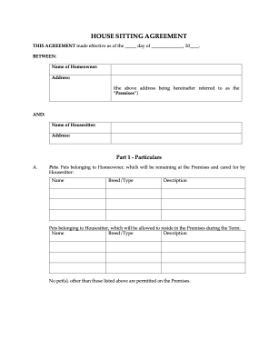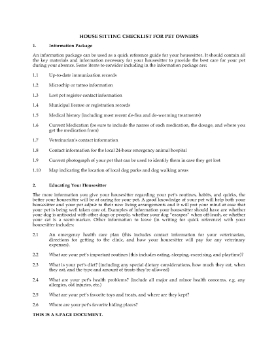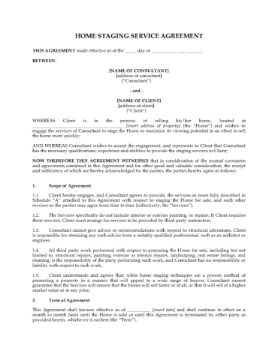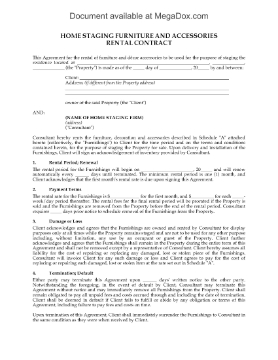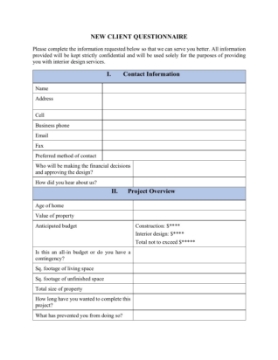Home Staging Contract
If you provide home staging and interior design services to customers who are preparing to sell their homes, you need to use a written Home Staging Contract.
This document sets out clear expectations and responsibilities for both service providers and homeowners, ensuring a professional and organized approach to staging projects.
Sale Guarantees and Pricing
The homeowner acknowledges that while staging can enhance the presentation of the property, it does not guarantee a sale or that the home will sell at the asking price. The contract clarifies that the results of staging are influenced by many factors beyond the control of the design consultant.
Staging Service Exclusions
The staging services outlined in the contract do not include the costs associated with hiring outside contractors. This means that expenses for painters, repair professionals, or other specialists needed to prepare the home are not covered by the staging agreement and must be handled separately by the homeowner.
Use of Furnishings and Additional Costs
Whenever possible, the design consultant will utilize the homeowner’s existing furniture and décor. If additional items are necessary, the homeowner is responsible for the costs of renting furniture, and purchasing any accessories or supplies required for staging and redesigning the property for sale.
Homeowner Responsibilities
The homeowner is solely responsible for packing personal belongings, de-personalizing and decluttering spaces, cleaning the home, and covering any storage costs for items that need to be removed during the staging process.
Proper Use of Rented Items
The homeowner agrees that rented items provided for staging will be used exclusively as display pieces and not for any other purpose during their time in the home.
Additional Clauses and Provisions
The contract includes additional clauses specifically for homes that are vacant prior to staging. There are also special provisions addressing services related to virtual tours, ensuring clarity for both in-person and digital presentations of the staged property.
Customizing the Agreement
Every service business benefits from a well-drafted customer agreement. The Home Staging Contract template is designed for interior design professionals, allowing you to download, personalize, and adapt the document to suit the exact needs of your business and your clients. One of our top 5 bestsellers!
Home Staging Furniture Rental Contract
Use this Home Staging Furniture Rental Contract to set out the rental terms for furnishings and decor used in staging a property for sale.
- Furniture and accessories are being installed for display purposes only. The clients and their family, guests and pets are not allowed to use the rental items during the staging period.
- The client is responsible for the costs of repairing or replacing any items lost or damaged by an occupant of the household or any guest or visitor.
- The client grants the staging consultant permission to enter and use the property for the purpose of installing the furniture and accessories and providing home staging services.
- The client is responsible for removing and storing all valuables.
- The client authorizes the consultant to move or rearrange any of the client's own furniture and personal property, except for specific named items.
- The consultant's liability will not exceed the total fees paid by the client.
- If you supply furniture and design accessories as part of your home staging service, you should use this contract form.
- Available in MS Word format and fully customizable to meet your exact needs.
Interior Designer Client Intake Form
Use this comprehensive Client Intake Form to develop a plan for an interior design project for a new client.
- The document comes in MS Word format and can be converted to a PDF form or to a web-based form.
- The form gathers information from the client regarding:
- details of the project, including budget, expected timelines and scope of work,
- a list of other project consultants and contractors (architect, builder, etc.),
- information about the household members, how they currently use the space and what their future plans and requirements are for the home,
- design goals and preferences, such as color schemes, types of flooring, window treatments, etc.
- The information provided by the client will allow you to build a profile from which the interior design plan can be developed.
House Sitting Agreement
Going away on holidays or business? Hire a house sitter and keep your home safe during your absence with this House Sitting Agreement.
- The agreement is NOT a lease, it is a license to occupy granting the housesitter the right to occupy the premises during the term of the agreement.
- In addition to the compensation being paid to the housesitter for providing services, the homeowner will pay the housesitter a stipend to cover food, gas and basic expenses.
- The housesitter will look after the home, the pets (if any), any plants in the house, the mail, the yard and grounds.
- The housesitter is responsible for keeping the property clean and for properly disposing of all trash and recycling.
- The housesitter must keep the premises secure by not leaving the premises unattended for long periods of time, by setting the alarm system (if any), and by not inviting any guests onto the property.
- The housesitter is liable for any loss or damage caused by any breach of the agreement.
- The homeowner agrees to indemnify the housesitter for any liability or claims, except those resulting from the housesitter's negligence or misconduct.
- The homeowner will keep the premises properly insured, but the house sitter is responsible for insuring his/her possessions and for carrying liability / public risk insurance.
- This is a generic legal contract template which can be used almost anywhere.
- Available in MS Word format.

